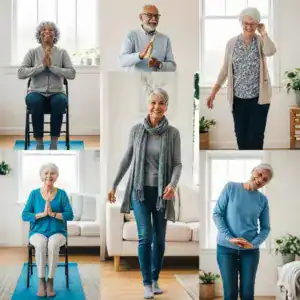
Exercise is a fundamental component of maintaining overall health and wellbeing, but its significance becomes even more pronounced as we age. Elderly people often lead a sedentary lifestyle, impacting both their physical and mental health. Although they use frequent medication to treat all kinds of health issues, senior exercise is something that plays an evident role without posing any adverse side effects.
In this article, we have discussed a few surprising health benefits of senior exercise, common types of exercises, barriers that seniors may face, and various effective ways to overcome them.
Keep reading to learn more!
5 Amazing Health Benefits of Exercise for Seniors
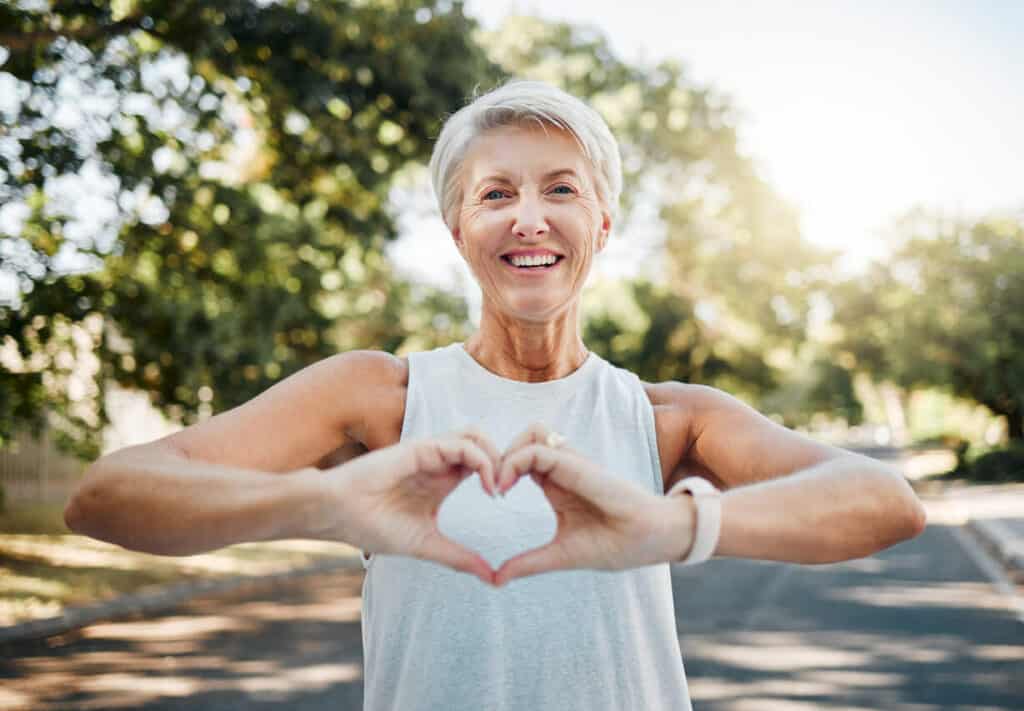
Regular exercise plays a vital role in improving the physical and mental well-being of older adults. Here are five inevitable benefits of everyday exercises for seniors that can improve the overall quality of life and longevity in the elderly.
Protects from Diseases
Older adults are prone to many diseases including cardiovascular, musculoskeletal, and other systemic issues due to degenerative changes in their bodies. A daily workout can help them avoid many health problems.
It enhances cardiovascular activity and reduces the risk of heart disease, high blood pressure, and stroke. Engaging in physical activity also helps improve insulin sensitivity, allowing the body to effectively regulate blood sugar levels and prevent diabetes and obesity.
It also promotes joint flexibility, strengthens the muscles, and reduces the risk of joint-related conditions such as arthritis.
Improves Mental Health
As Elle Woods says in the movie Legally Blonde, “Exercise gives you endorphins and endorphins make you happy…”.
Workout stimulates the release of endorphins, also known as “feel-good” hormones. These hormones reduce the symptoms of stress, anxiety, and depression. Moreover, they significantly enhance the mood of elderly people and promote a sense of happiness.
Exercises for senior citizens also help lower the production of stress hormones, such as cortisol, and increase the levels of serotonin and dopamine which play a vital role in relieving anxiety and improving their mental health.
Enhances Cognitive Function
Regular exercise has been reported to improve cognitive function and enhance memory, concentration, and attention. It promotes blood flow to the brain, and increases the delivery of oxygen and nutrients, hence, supporting the growth and survival of brain cells.
It also stimulates the release of growth factors that facilitate the formation of new connections between neurons. This promotes brain plasticity, the brain’s ability to adapt and change, which is particularly important for learning, memory, and overall cognitive function.
Engaging in physical activity has also been associated with a reduced risk of cognitive decline and dementia in older adults.
Reduces Risk of Falls and Accidents
Falls and accidents are quite common in the elderly and exercise plays a crucial role in reducing the risk. Regular senior exercise can improve balance, strength, flexibility, and overall fitness, which are essential for stability and prevention of falls while moving.
Balance exercises enhance proprioception (awareness of body position) and coordination. Strengthening exercises for elderly people build their muscle strength, providing more support to joints. Weight-bearing exercises also improve bone density, hence, lowering the risk of fractures.
Improves Quality of Life
Exercise significantly improves the overall quality of life for seniors. It increases their energy levels, promotes better sleep patterns, and enhances overall functional abilities. It also helps seniors keep up their active lifestyle and enables them to continue participating in activities they enjoy and maintaining their social connections.
Moreover, the sense of accomplishment and improved confidence that comes with regular exercise leaves a positive impact on their daily life.
5 Types of Exercises for Seniors
Fitness for seniors is crucial to keep up their level of independence and quality of life. Different types of senior exercises cater to different aspects of physical wellbeing. Here are 5 categories of exercise for seniors that will benefit your loved one.
Aerobic Exercises
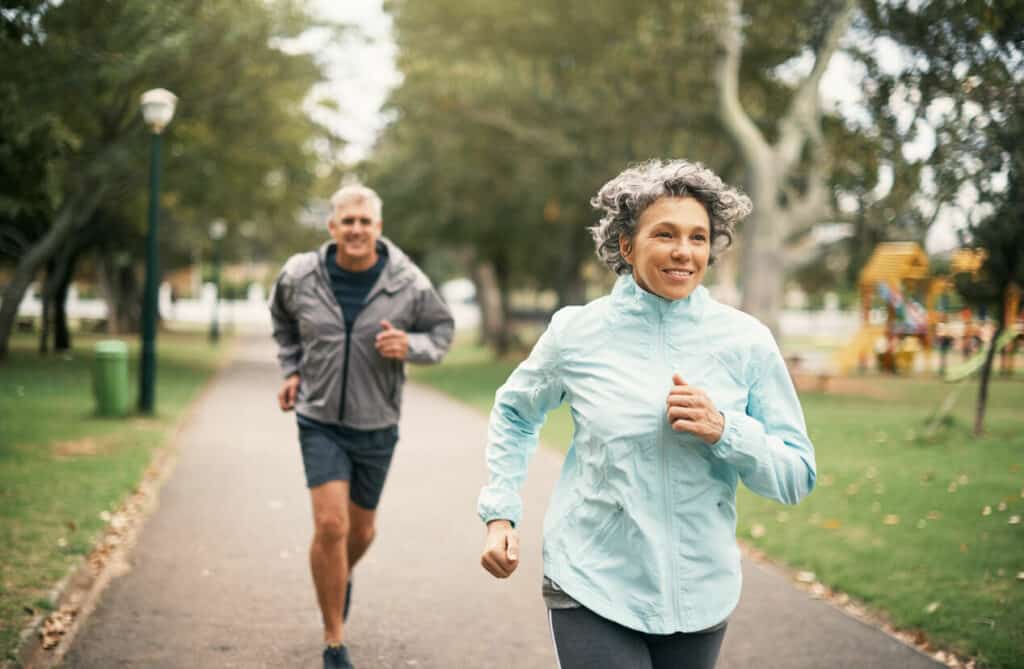
Aerobic exercises are also known as endurance or cardio exercises. They use the larger group of muscles and increase the heart output and breathing rate to meet the demand of the body. These exercises make the heart stronger, increase endurance, and improve overall health.
Some effective low-impact aerobic exercises for seniors include:
- Sitting Exercises (marches, ankle ABCs, bicep curls, sit-to-stand)
- Yoga
- Brisk Walking
- Swimming
- Cycling
- Water aerobics
- Golf
It is recommended to start slowly and gradually increase the duration and intensity of the exercises. Also, consult with a healthcare professional before starting a new exercise program.
Strength Training

Strength training exercises are also known as resistance exercises. They are beneficial in maintaining muscle mass, improving bone density, and enhancing overall physical strength. Your loved one can use hand weights, resistance bands, and their own body weight while performing these exercises to build strength.
When it comes to strength training exercises for older people, it’s important to choose exercises that are comfortable, safe, and suitable for their fitness level. Here are a few examples:
- Chair Squats
- Wall-Push ups
- Bicep Curls
- Leg Raises
- Standing Heel Raises
- Shoulder Press
- Step-Ups
- Standing Lunges
Begin the strengthening exercises for your elderly with light weights or low resistance and gradually increase according to their stamina. It’s important to follow proper techniques during each exercise to prevent injury.
Flexibility Exercises

Flexibility exercises for seniors are also referred to as stretching exercises. They improve joint mobility, enhance muscle elasticity, and reduce the risk of pain and injury. They also enhance posture and improve mobility and flexibility.
Stretching exercises help alleviate stiffness and increase range of motion, allowing seniors to perform activities of daily living (ADLs) with ease.
Here are some flexibility exercises suitable for seniors:
- Shoulder Rolls
- Neck Stretches
- Seated Forward Bend
- Ankle Rotation
- Seated Trunk Rotation
- Hamstring Stretch
- Calf Stretch
- Overhead Flexion
- Knee-to-Chest Stretch
Gentle stretching exercises that target major muscle groups should be performed daily. It is also recommended to warm up before stretching and avoid pushing too hard, as this can cause muscle strain and injury.
Balance Training
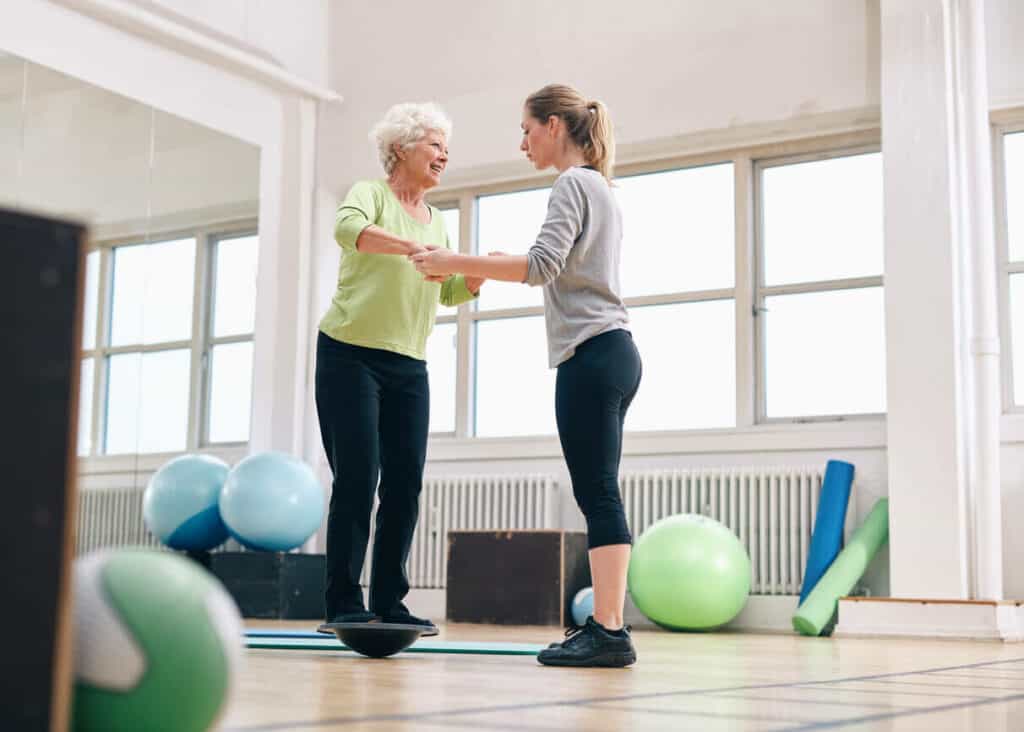
Balance training exercises for seniors help prevent falls and maintain stability. With age, balance, and coordination tend to decline, making it essential to engage in exercises that challenge and improve balance in older people.
Incorporating balance training into a regular exercise routine can significantly reduce the risk of falls and injuries, promoting confidence and a healthy lifestyle.
Examples of balance exercises for seniors include:
- Single Leg Stance
- Heel-to-toe Walk
- Single Leg Lifts
- Walking on uneven surfaces like a foam pad, carpeted surface, or balance disk
- Step-up
- Sideways Walking
For added safety when performing balance exercises with the elderly, it’s always necessary to supervise them and provide sturdy support nearby. A professional elderly caregiver can provide the much-needed support your loved one needs while exercising.
Mind-Body Exercises

Mind-body exercises focus on the connection between the mind and body. These exercises are particularly beneficial for seniors, as they help alleviate anxiety and depression and enhance their psychological wellbeing.
Engaging in mind-body exercises regularly helps seniors reduce stress, improve sleep quality, and cultivate a sense of inner peace. These exercises can also enhance cognitive function and memory
Here are some mind-body exercises that promote relaxation, stress reduction, and overall health:
- Yoga
- Tai Chi
- Mediation
- Deep Breathing Exercises
- Qi Gong
- Guided Imagery
- Dancing
Seniors can join group exercise classes or follow instructional videos to perform exercises. A caregiver can also guide seniors in selecting the right types of exercises based on their physical abilities after consulting with the physical therapist.
What are the Common Barriers to Senior Exercise?
Several barriers exist that often discourage seniors from participating in regular physical activity. Here are four of the most prevalent obstacles faced by seniors when it comes to exercise and some practical solutions to overcome them.
Lack of Motivation

One of the primary barriers to senior exercise is the lack of motivation. Aging causes declining changes in physical abilities and stamina, which makes seniors feel less inclined to engage in any activity. Also, being confined at home and dependent on caregivers may lead to a sedentary lifestyle and limited social interaction that may contribute to a lack of motivation.
In order to overcome it, you can help seniors focus on finding activities they enjoy and that align with their interests. Engaging in group exercise classes or finding a workout buddy can also provide motivation and social interaction. Setting realistic goals and tracking their progress also boost their morale and help them stay committed to their exercise routine.
Fear of Injury
Due to physical frailty and a higher risk of falls, older people develop apprehension about engaging in any physical activity that may seem risky. They may worry about their ability to recover from any possible injury or its potential impact on their quality of life. This fear can create a mental barrier that hinders their willingness to participate in a senior exercise program and limits their functional capabilities.
You can overcome their fear of exercise by starting them off with low-impact exercises like walking, swimming, and cycling. These exercises are gentle on their joints, produce lesser strain, and reduce the risk of injury.
Additionally, consult with a professional therapist to help pick the right exercises and techniques for seniors to gradually build their confidence. Assistive devices like canes or walkers also provide added support to help overcome the fear of injury.
Lack of Time
Lack of time is one of the common barriers to exercise in elderly people. Their physical responsibilities, medical appointments, and other commitments make it challenging for them to prioritize exercise in their daily routine. In the midst of all other chores, taking out time to do some workout seems like an impossible feat.
However, planning ahead is crucial in overcoming the time barrier. You can schedule exercise sessions in their daily or weekly planner, just like any other important appointment. Their friends or care home buddies can be invited to join in for group exercise sessions to build a sense of accountability.
Exercise programs can be divided into smaller, more manageable sessions like 10 minutes of stretching multiple times in the day instead of a one-hour long session. Exercise can also be made a part of their daily routine to manage time while achieving the fitness goals such as walking around the house for chores.
Limited Access to Facilities or Equipment
Limited access to facilities or equipment can act as a barrier to exercise for seniors in several ways. Many seniors may not have a nearby gym or fitness center within their immediate vicinity.
This lack of proximity can make it inconvenient and time-consuming for seniors to travel to exercise facilities regularly, especially for those with limited mobility or access to transportation. The cost associated with gym memberships or fitness classes can pose a financial challenge for some seniors.
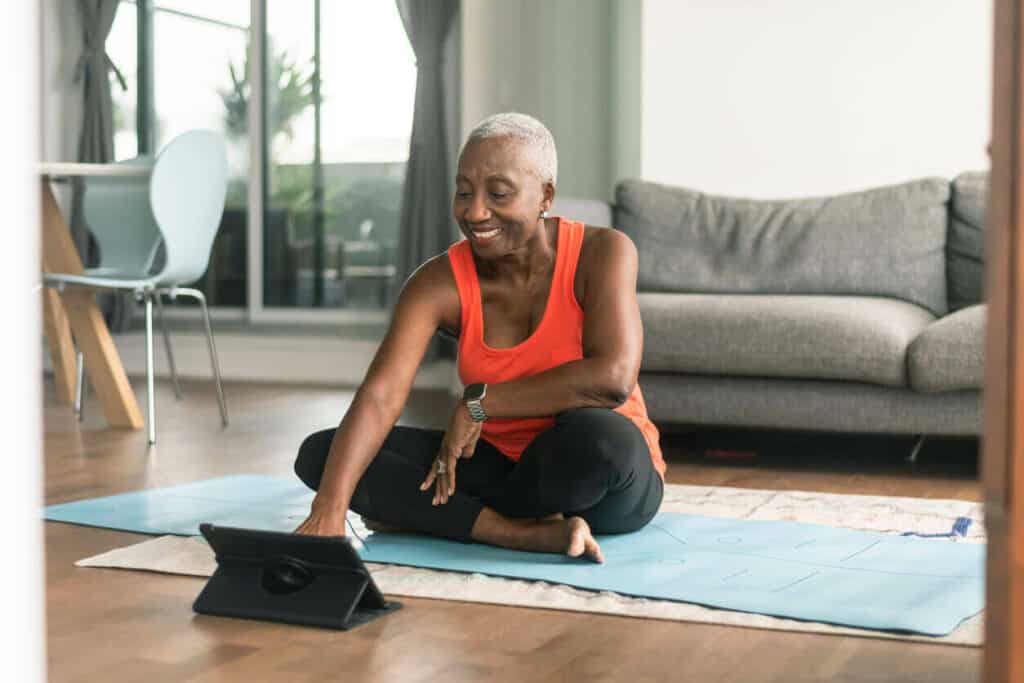
Alternatively, you can explore other options for senior
exercise that do not require expensive equipment or access to fitness centers. There are some home exercises for the elderly that can be performed in the comfort of their homes without the need for specialized equipment.
Walking in a nearby park is a great way to do cardiovascular exercise in a natural environment. You can also easily find exercise videos for seniors online that they can watch and follow. Many fitness professionals offer free or low-cost exercise programs that can be accessed from the comfort of your home. These programs often require minimal or no equipment and provide professional guidance by demonstrating exercises for seniors with pictures or videos.
5 Ways How to Encourage Exercise for Seniors
As we already mentioned, seniors often face the fear of injury, lack of time and motivation, and limited mobility that can stop them from adapting to a senior exercise routine. So, you might need different ways to engage them in exercise and keep them going. Some ways you can do that include:
Educate Them About The Benefits
Seniors might see workouts as a time-consuming and exhausting activity and tend to avoid it. They may not be fully aware of the various benefits of exercise in improving their level of independence. It is essential to educate older people about the impact of exercise on their bodies and discuss its mechanism.
Many people only follow something when they know how it works. Elderly people do not like to depend on others and their declining independence often makes them stressed. When you tell them how exercise will help them take control of themselves, they’ll be more encouraged to participate in the exercise routine regularly.
Tailor the Exercise Program

Older people are more likely to take an interest in an exercise plan that’s customized to their individual needs. Every person has their own fitness level, functional limitations, and preferences when it comes to designing an exercise program.
Some older people might prefer doing exercise alone while others, in group activities. Some older people might be able to perform seated exercises only while others with better mobility might do exercises while standing too.
It is also important to take into consideration any pre-existing health issues like Parkinson’s or Dementia that might affect certain exercises. So, you need to discuss everything with your physical therapist to tailor the workout routine for seniors according to their needs.
Create a Supportive Environment
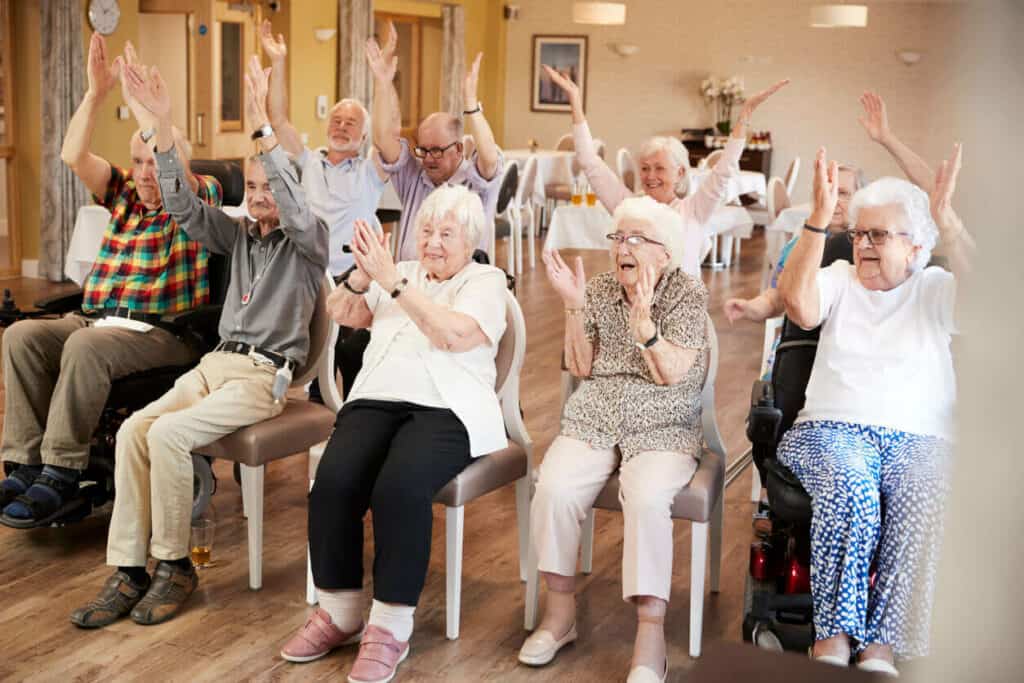
The environment in which seniors exercise can significantly impact their willingness to engage in exercise routines. Creating a supportive and encouraging environment is crucial to fostering a positive exercise experience.
One way to achieve this is through group exercise sessions specifically designed for seniors. These sessions not only provide organized exercise but also offer social interaction and support from peers.
Apart from that, doing workouts along with a friend or family member also makes the activity more enjoyable and helps maintain accountability. If your loved one enjoys outdoor activities more, you can organize exercise plans for them in a nearby park or garden. You also need to ensure that the exercise space is safe, well-lit, and easily accessible to make seniors feel comfortable and confident.
Set Realistic Goals

You’re more likely to keep seniors engaged in their exercise routine if you set realistic and achievable goals, and don’t overdo it. Unrealistic expectations can lead to frustration and discourage them from continuing with their exercise routine.
Start by setting small, attainable goals and gradually increase the intensity or duration of the exercises over time. Breaking down the goals into smaller milestones allows seniors to track their progress and experience a sense of accomplishment.
It is important to emphasize that every effort counts and that consistency is key. By setting realistic goals, seniors are more likely to stay motivated and committed to their exercise routine.
Celebrate Progress
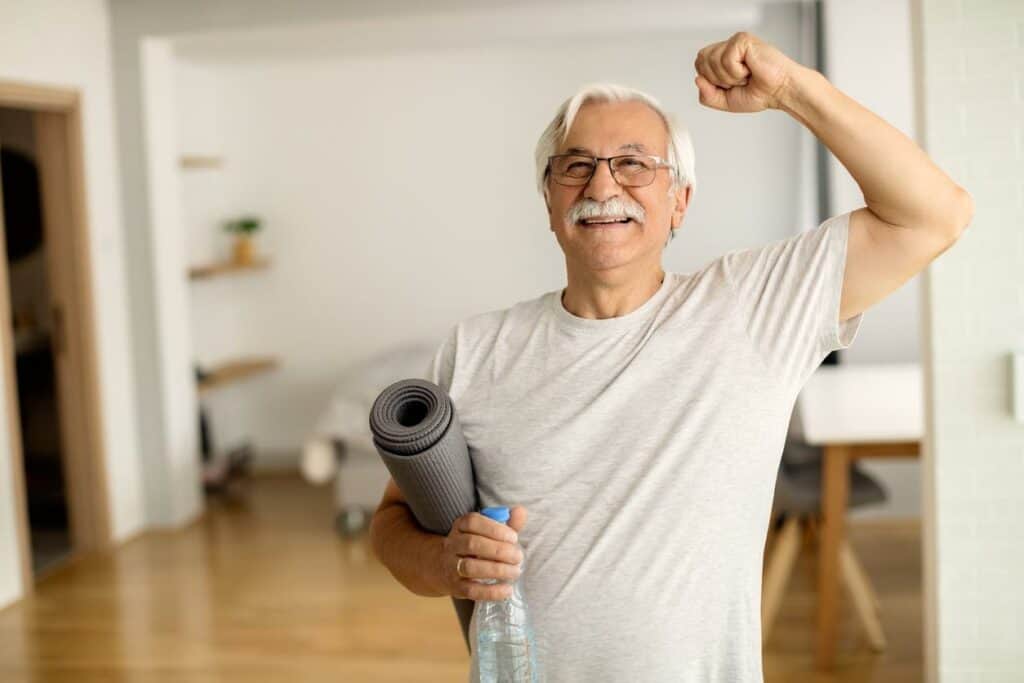
Recognize and celebrate the progress of your elderly loved ones in their exercise journey to maintain their motivation and commitment. When seniors achieve their milestones, it is important to acknowledge their accomplishments and provide positive reinforcement.
You can do that by verbal praise, small rewards, or even recording their progress in a journal.
Celebrating progress not only boosts their confidence but also reinforces the importance of exercise in their lives. It is also crucial to remind seniors that setbacks are a natural part of the process and should not discourage them. By focusing on the progress made, seniors are more likely to remain engaged and continue their exercise routine.
Conclusion
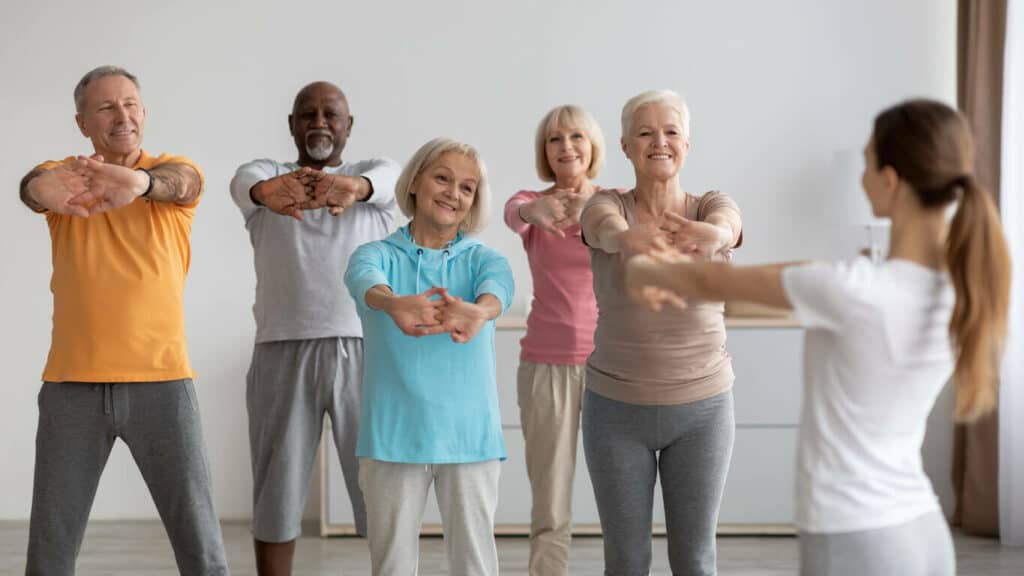
The bottom line is that exercise for seniors is like a magic elixir that not only enhances functional mobility, sleep patterns, and mental well-being but also elevates the overall quality of life.
Depending on the specific needs of the elderly individual, they can benefit from different types of exercises. It’s important to understand that older people might encounter barriers to exercise, such as fear of pain, time constraints, or a lack of motivation. However, Remember, it’s always wise to consult a healthcare professional for personalized advice on nutrition and exercise. With these top tips in place, seniors can enjoy the physical and mental benefits of exercising well into their golden years.
At Amy’s Eden, we provide regular senior exercise sessions supervised by our caregivers, both in our assisted living homes and our client’s homes. We ensure privacy and comfort by consulting with physical therapists to design a safe, fun, and engaging senior workout routine.
Feel free to contact us today if you’re looking to hire our caregivers who can provide valuable assistance to your loved ones with the best senior exercises and other daily living activities.



